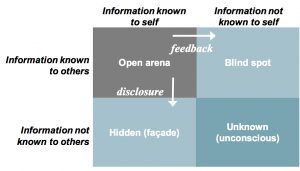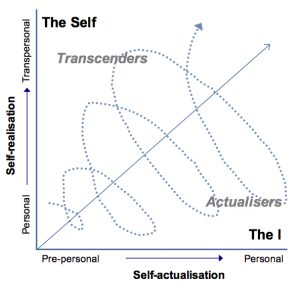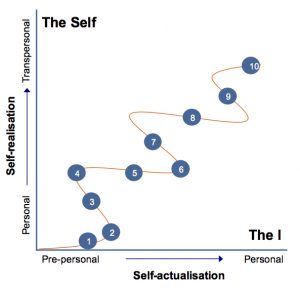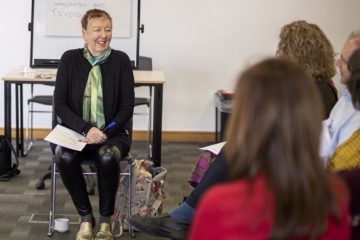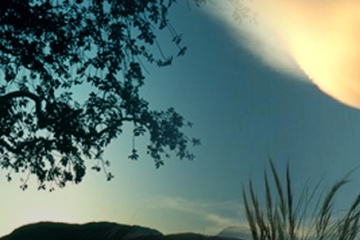Personal development and the leadership coach
16th September 2018
Aubyn Howard
‘The unexamined life is not worth living…’ Socrates as reported by Plato
Why are personal and professional development inseparable in coaching? Within psychosynthesis coaching, we view the coach’s ability to practice a psychospiritual approach as a function of their own level of personal development, psycho-spiritual training and coaching skills. In this post, I explore what we mean by personal development and how it combines with professional development for the psychosynthesis coach…
Part 1: establishing the context
Most coaching approaches will put some attention on personal development for the coach. Sometimes this can be little more than lip service and in other cases it represents a more serious commitment. It is interesting to note that APECS is unique amongst the coaching professional bodies in asking potential members to describe their previous development in terms of professional and personal development (which they term CPPD).
Psychosynthesis coaching involves working with the inner as well as the outer world of our clients and always holding a developmental context alongside other agendas and goals. The inner world concerns our interior lives of thoughts and feelings, hopes and fears, dreams and anxieties, our light and our shadow, the heights and depths of our unconscious, not just our everyday awareness. The territory includes working with the psyche and the Self in all its dimensions, which I have described in a previous post. Within this context, personal development is both essential and central to the development of the coach and their professional practice. Personal development isn’t an add-on or optional extra to professional development, it is what makes coaching in this way at deeper levels possible and increases our capacity to do it well. It is important that we show why this is the case and explore what we mean by personal development in this context – that is what this post is about.
I am inviting you as the reader to take a closer look at your relationship with your own development and to challenge you to reflect upon it in new ways. I will go further and suggest that it would be fairly pointless to learn about psychosynthesis coaching as an approach which encompasses various methods, models, tools and skills, without continuously drawing upon yourself and your own experience of development as an inner reference point.
Psychosynthesis can itself be described as an holistic approach to personal development, involving what Roberto Assagioli called personal and transpersonal psychosynthesis, as we follow our individual journeys towards self-realisation and self-actualisation. Following a brief introduction to the topic of personal development, I will expand upon this psychosynthesis context with specific reference to Assagioli’s work.
What is personal development?
Personal development is a vast and complex topic that can be approached in many different ways. It is inter-woven with the whole field of psychology, the story of the human potential movement, the leadership and talent development world, the popular self-help industry and of course the modern coaching profession. You are likely to have your own understanding of what personal development is based upon your history and experience, so whatever your starting point and whatever perspectives you bring are valid and relevant to the theme we are exploring here.
I choose the work of Abraham Maslow and his concepts of self-actualisation and the hierarchy of needs as a useful starting point for defining personal development, not least because many others have done so before me.
As early as 1943 Maslow defined self-actualisation as “… the desire to become more and more what one is, to become everything that one is capable of becoming.” Adding to this, the ‘Skills You Need’ website says:
Self-actualisation refers to the desire that everybody has ‘to become everything that they are capable of becoming’. In other words, it refers to self-fulfilment and the need to reach full potential as a unique human being. Maslow also says (1970, p.383) that all individuals have the need to see themselves as competent and autonomous, also that every person has limitless room for growth.
This website then offers a number of practical steps and resources for creating your vision, planning, starting, recording, and reviewing your personal development. This is certainly a useful introduction to the discipline of personal development for many people working in organisations.
In an on-line blog post, Myrko Thum defines Personal Development as ‘the conscious pursuit of personal growth by expanding self-awareness and knowledge and improving personal skills’ and quotes Jung’s “until you make the unconscious conscious, it will direct your life and you will call it fate”, as a way to focus personal development on working with the unconscious. He goes on to cite the well-known four stages of competencemodel (first articulated by Martin Broadwell in 1969) – where we start in unconscious incompetence in our relationship to a skill or capability (it’s not on our radar), then move to conscious incompetence as we recognise the need to develop the capability (we want to be able to do it), eventually build our conscious competency (we can do it but we need to think about it) before this becomes habit and part of our unconscious competence (we do it automatically). I have often seen trainers explaining this sequence using the example of learning to drive to illustrate the stages, but really it can be applied to anything, including coaching skills and models.
Another well-known tool for working with the conscious and unconscious in relation to personal development is the JoHari Window – created by psychologists Joseph Luft (1916–2014) and Harrington Ingham (1916–1995) in 1955, as a model that helps people better understand their relationship with themselves and others. A simple four quadrants grid is created by combining what is known to self and unknown to self on one (X) axis, and what is known to other sand not known to others along the other (Y) axis. This creates four ‘windows’ (or ‘rooms’ as Charles Handy used to say), namely the open space, the hidden area, the blind spot and the unknown. The objective in terms of improving relationship with others is to maximise the size of the open arena through exercising the key skills of appropriate self-disclosure (to reduce our hidden area) and asking for and receiving feedback (to reduce our blind spot area). Of course, this is easier said than done and takes a life time of practice, but this represents another useful starting point for engaging in personal development alongside team and organisational development.
The JoHari Window (created by Joseph Luft and Harrington Ingham)
When I first encountered this model in the 1990’s, I was always curious about how we might explore the unknown or unconscious area more fully and was never very satisfied with the answers I received at the time. Amongst other things, this led me to study psychosynthesis which uniquely seems to provide a holistic map of the psyche which can help us recognise and navigate all the dimensions of our consciousness and unconsciousness, including what is sometimes called the shadow. To quote Robert Bly, “Shadow” is one of Carl Jung’s most useful terms for a part of the human psyche… it conveys a visual image – we might call the shadow “the dark, unlit and repressed side of the ego complex”.
My own conception of personal development is that it concerns the continuing development of the person, the whole human being, of our personhood, however we might say it*. Personal development is loosely synonymous with self-development and personal growth, although as a term it is now the most commonly used to refer to the discipline, practice and professional field of working on ourselves. It is important to remember that this practice is always owned by ourselves, by the individual, and that we hold agency and responsibility for it. I cannot have a personal development objective for you, only for myself, although I can support you in your personal development, as we do as coaches.
The implication here is that we need a theory or model of the person, of the whole human being as a reference point for personal development. Without this, different approaches tend to work unconsciously from a received set of assumptions about the psyche that have not been made explicit. Psychosynthesis offers such a model, as well as a more nuanced understanding of where personal development might take us, and this is now where I will turn.
* A brief aside – we are using the word personal in several different ways, which may cause some confusion. As well as meaning of the person, as described above, it also confers the meaning of individual, so when we refer to personal development we are really referring to our unique individual development (as opposed to team or organisational development). Within this broad sense of the person, we focus on the personality, as with the use of personality profiling tools and addressing personality edges and issues. Finally, within psychosynthesis we are using personalto describe the middle or most accessible realm of the human consciousness, as opposed to the lowerunconscious or prepersonal, or the higher unconscious or transpersonal. Personalcan also be used to mean the private (or off-limits in leadership coaching) aspect of our lives (as contrasted with business-personal), but we are not drawing upon that meaning here. Phew, this can be complicated!
Psychosynthesis as a path for personal development
The relationship between Maslow’s and Assagioli’s work and how they informed each other is a recurring topic in my writing. Assagioli recognised ‘that people are not equally developed from the psychological and spiritual point of view’ (1988, p107) and offers a way of understanding how personal development takes place along two inter-related but distinct dimensions. He recognises and endorses Maslow’s work concerning self-actualisation but shows how this only takes us so far in terms of understanding how people develop and grow psycho-spiritually.
Drawing upon his map of the psyche (the Egg diagram), which distinguishes between prepersonal, personal and transpersonal levels of consciousness (see here), Assagioli distinguishes these two dimensions of development (1974, p121):
In the terminology of psychosynthesis, self-actualization corresponds to personal psychosynthesis. This includes the development and harmonizing of all human functions and potentialities at all levels of the lower and middle area in the diagram of the constitution of man. Instead, Self-realization concerns the third higher level, that of the superconscious, and pertains to transpersonal or spiritual psychosynthesis.
Maslow’s later work recognises this distinction as he starts to speak in terms of transcending self-actualisers as well as non-transcending self-actualisers. Assagioli’s model of individual self-actualisation and self-realisation is our orienting model for psychosynthesis coaching in relationship to personal development. There has been much debate within psychosynthesis world about the relationship between the two dimensions of development; whether they are sequential (personal psychosynthesis broadly preceding transpersonal psychosynthesis), concurrent (we are working on both aspects much of the time) or follow a pattern that is unique to each individual (which I tend to favour). In the graphic above I have drawn a spiral as an example of the way we might illustrate a personal journey alternating between the two dimensions.
The important thing is that this model helps us hold the tension between self-actualisation and self-realisation and to be curious about the developmental journey of ourselves and our clients. For example, some of us might lean towards self-realisation (transcenders) and others towards self-actualisation (actualisers) in our personal development journey. This gives us a clue as to the type of challenges and crises we might encounter along the way. Transcenders tend to encounter crises of duality as they struggle with embodiment, with being spirit in matter, with making their way in the world and dealing with the practicalities of life. Actualisers tend to encounter crises of meaning as they strive to achieve and succeed, often evoking considerable stress in pursuit of actualising their potential in the world. Some of us will recognise both states from reflecting upon different periods of our life, and we might start to trace a pattern which resembles the spiral above (see my example below).
The focus of personal psychosynthesis is on developing a strong and healthy personal “I” (sometimes referred to the I-self, small self or the personality), as the centre of our everyday awareness and self-consciousness, the psychological container and vehicle through which we experience our higher Self and actualise our potential in our lives through engaging our will. This is about being able to function happily and effectively as human beings, both in our inner experiential lives and our outer lives of relationships and actions. This part of personal development is about working on ourselves and the personality edges, blind spots and distortions that are unwelcomed and unconscious echoes of the past. The key here is building a level of self- awareness, knowledge and acceptance that gives us sufficient psychological and behavioural freedom to activate our will, rather than necessarily changing the way we are, which is not always possible or even desirable!
The focus of transpersonal psychosynthesis is on the higher Self – who we are most essentially, the source of our being and our becoming. Without getting too technical about this more spiritual domain, this is the territory of all the ancient and modern paths to self-realisation, self-discovery or enlightenment. This part of personal development is about learning to listen to, resonate with, reach towards and recognise our essential being and unrealised potential. This is particularly difficult because most of the time we are too identified with different parts of our experience, personality, or outer lives to be able to listen to the Self. Hence the need to start with personal psychosynthesis and the practice of disidentification and identification. This work is about discovering meaning and purpose for our lives from within rather than externally.
To explain more fully what Assagioli meant by self-realisation in a psycho-spiritual context, I will paraphrase from Psychosynthesis (1965, p21-22):
attaining the goal of self-realisation begins with getting to know and mastering our personality. This involves an inner exploration of our lower, middle and higher unconscious, in other words, working on ourselves at different levels, to discover our true abilities and higher potentialities, and thus engaging self-actualisation. This leads to the recognition and realisation of our true or higher Self, which becomes the unifying centre for our further development – transpersonal psychosynthesis.
Within this, the starting point and main focus of the work of personal development is best summarised as getting to know and mastering our personality, through exploring all levels of our consciousness. This is an important message both to ourselves as coaches and for those we are coaching and gets missed in more superficial approaches to personal development that only emphasise developing skills and behaviour.
Finally, let me use my own life as a (highly simplified) example of the interplay of these two dimensions – following every appearance of outward success at school (1), I hit a crisis of identity and meaning as a young adult at university (2), that led to an inner search for truth and understanding of who I was (3), in which I embarked upon a path that led to a series of peak experiences and profound self-realisation (4), liberating me to express myself fully and experience an extended period of career achievement (5), culminating in a gradual return to self-doubt and questioning at a deeper level (6), leading me to engage in a rich period of personal and professional development (7), fuelling a new phase of actualisation in the organisational world (8), before responding to a pull towards my current work with psychosynthesis coaching, bringing inner healing and resolution (9), which I am now channelling into my courses and writing (10). Elsewhere (in the book I am writing), I will unpack this journey in a little more detail, colouring in my personal development in terms of aspirations, strengths, issues and edges during each of these phases, as well as how this translates into Assagioli’s language of personal and transpersonal psychosynthesis. For now, I simply want to show an example of how these phases illustrate cycling between periods of working on self-realisation and self-actualisation.
What next?
Having established this contextual foundation for how we might approach personal development as psychosynthesis coaches, in my next post I will introduce a model to help us and our clients recognise the psychological issues and personality edges that most need working on. I will then explore the following seven perspectives for coaches engaging with personal development:
1: it starts with an attitude –why attitudes need continuous reflection and renewal
2: know thyself, know thy client –appreciating the psychospiritual territory in which we are working as a guide
3: what’s my stuff, what’s your stuff? – and how does my stuff get along with your stuff?
4: ways of working on yourself – formal and informal, obvious and not so obvious
5: finding your edges to work on – this tricky part of personal development
6: assessing your personal development – ways of reviewing progress
7: knowing it’s always personal – not leaving ourselves out of the picture
The second post on this topic of personal development for the leadership coach will follow soon!
Thanks for reading.
Aubyn
P.S. Tickets for our Psychosynthesis Coaching Symposium on 14thNovember are now on sale at:
https://www.eventbrite.co.uk/e/first-annual-psychosynthesis-coaching-symposium-tickets-50022564838
References
Assagioli, Roberto (1965), ‘Psychosynthesis’
Assagioli, Roberto (1974), ‘The Act of Will’
Assagioli, Roberto (1988), ‘Transpersonal Development’
Bly, Robert (1988), ‘A little Book on the Human Shadow’
Maslow, Abraham (1968), ‘Towards a psychology of Being’
Maslow, Abraham (1970), ‘Motivation and Personality’, (2nd Edition)
Myrko Thum: https://www.myrkothum.com/what-is-personal-development/(2012)
Skills Your Need: https://www.skillsyouneed.com/ps/personal-development.html(2018)

